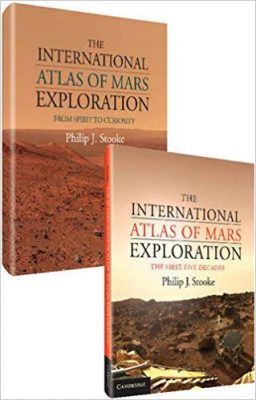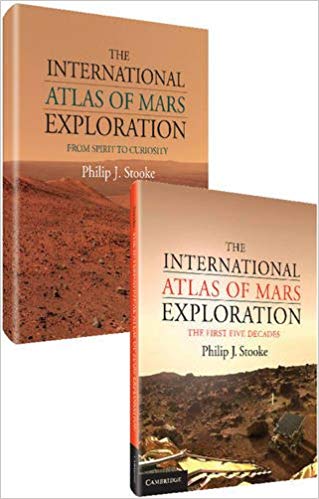 Volume I: 1953 to 2003 – The First Five Decades – 359 pages
Volume I: 1953 to 2003 – The First Five Decades – 359 pages
Volume II: 2004 to 2014- From Spirit to Curiosity – 444 pages
Author: Philip J. Stooke
Publisher: Cambridge University Press – 803 pages total
Book Review by: Sonu Chandiram
The most recent mission to Mars entitled Insight launched on May 18, 2018, is expected to land on that planet on November 26, 2018. We shall be watching.
The two volumes of this book together constitute, to my present knowledge, probably the most comprehensive and most visually detailed atlases on the exploration of Mars, often referred to as the ‘Red Planet’. These two volumes tell the stories of every Mars mission, including about 30 missions that failed, from the dawn of the Space Age to the Mars Express from the early 1950s to early the 2000s, and to the more recent missions entitled Spirit, Opportunity and Curiosity.
The Mars mission launched November 26, 2011 prior to the one launched on May 18, 2018 consisted of a car-sized module known as ‘rover’ that landed about eight months later, after a 560 million mile journey, on August 6, 2012 on an area called Aolis Palus in the Gale Crater.
The goals of the Curiosity mission were in general to explore the climate and geology of Mars, and specifically to discover if the field within that crater has, or ever had environmental conditions conducive to microbial life.
The planners of the Curiosity mission wanted to do an investigation on the role of water in the probable habitability of Mars. The rover is still operational as of today, October 4, 2018, and has been on Mars for 2,250 days, or over six years.
Beside the above-mentioned reasons, why explore Mars instead of other planets in our Solar System? Here are some of them pertaining to distance, size, and rotation:
Mars is the fourth planet in distance from the Sun, and the second smallest in size in our Solar System after Mercury
Mars is one of the closest planets to our own Earth. In theory, the closest that Earth and Mars would approach each other would be when Mars is at its closest point to the sun (perihelion) and Earth is at its farthest (aphelion). This would put the planets only 33.9 million miles apart
Mars’ diameter is 6790 kilometers, just slightly larger than half the diameter of Earth, which is 12,750 kilometers
The rotational period and seasonal cycles of Mars are likewise similar to those of Earth, as is the tilt that produces the seasons. In astronomy, the rotation period of a celestial object is the time it takes to complete one revolution around its axis of rotation relative to the background stars
While the journey of the Curiosity mission was 560 million miles and not undertaken when the distance of Mars from Earth was much closer, there are many reasons why a mission is undertaken at a certain time, and we are not going to get into that matter in this book review.
We list below the outline of contents in each of these volumes, to provide you brief overviews:
- Volume I Contents:
- Missions and events – chronological list
- Foreword by Matt Golombek
- Preface and acknowledgments
- Chronological sequence of missions and events
- Phobos and Deimos
- Mars mission data
- Bibliography
- Index
- Volume II Contents:
- Missions and events – chronological list
- Foreword by Andrew Chaikin
- Preface and acknowledgments
- Chronological sequence of missions and events
- Phobos and Deimos
- Updates to Volume 1
- Mars mission data
- Bibliography
- Index
Among the notably important features of Volume I are the following:
- An easy-to-follow, step-by-step history of Mars exploration
- Each story is illustrated with a combination of maps and annotated photographs
- Phobos and Deimos, the moons of Mars, are covered in a separate section
- The atlas also includes missions that were planned but never flown
Volume II provides these key features:
- Rare and never-before published data and information on the history of most recent Mars missions and exploration
- Over 200 illustrations show the exploration of Mars in a systematic manner
- Maps of each stage of exploration and step-by-step images of robotic arm and rover operations
- An accessible guide to both the scientific development and historical background of Mars exploration
This is probably one of the best, and likely. the best book available on the exploration of Mars. It includes details of all missions undertaken from the beginning. It is also very richly illustrated.
Author:
Philip J. Stooke is a cartographer and imaging expert at the University of Western Ontario, whose interest in mapping the Moon and planets began during the Apollo missions. He has developed novel methods for mapping asteroid, and many of the asteroid maps are now available from NASA’s Planetary Data System.
He has studied spacecraft locations on the Moon and Mars, notably locating Viking 2 on Mars. He is the author of many papers and articles on planetary mapping, planetary geography, and the history of cartography and planetary science. His book The international Atlas of Lunar Exploration was published by Cambridge Press in 2008.
This was followed by The International Atlas of Mars Exploration: The First Five Decades, published by Cambridge University Press in 2012, which was selected as an Outstanding Academic Title by the American Library Association in 2013.







